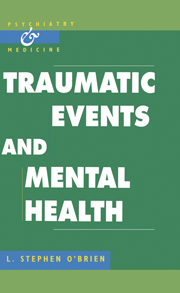Book contents
- Frontmatter
- Contents
- Foreword
- 1 Introduction and historical perspective
- 2 Normal reactions to trauma
- 3 Epidemiology of post-traumatic stress disorder and post-traumatic illness
- 4 Aetiology and predisposing factors
- 5 What constitutes a stressor?
- 6 Post-traumatic illness other than post-traumatic stress disorder
- 7 Diagnosis and assessment
- 8 Management and outcome of post-traumatic illness
- 9 Medicolegal aspects of post-traumatic illness
- 10 Prevention of post-traumatic illness
- 11 The way ahead – whither now?
- Index
5 - What constitutes a stressor?
Published online by Cambridge University Press: 05 May 2010
- Frontmatter
- Contents
- Foreword
- 1 Introduction and historical perspective
- 2 Normal reactions to trauma
- 3 Epidemiology of post-traumatic stress disorder and post-traumatic illness
- 4 Aetiology and predisposing factors
- 5 What constitutes a stressor?
- 6 Post-traumatic illness other than post-traumatic stress disorder
- 7 Diagnosis and assessment
- 8 Management and outcome of post-traumatic illness
- 9 Medicolegal aspects of post-traumatic illness
- 10 Prevention of post-traumatic illness
- 11 The way ahead – whither now?
- Index
Summary
By definition, post-traumatic illness follows some sort of trauma. It has been recognised for many years that illness can follow trauma. However, what constitutes trauma is far from clear. In particular the type or extent of trauma necessary to cause PTSD is an issue which has been argued fiercely since PTSD was defined in DSM-III.
The whole concept of PTI is that it would not have occurred if it were not for a preceding trauma. The evidence is that there certainly is an excess of mental illness following major traumatic events, and this suggestion is not generally challenged.
The concept of PTSD in particular, on the other hand, demands more than that it be an illness which occurs in response to traumatic events. In addition it has to be an illness which occurs only following certain particular classes or severity of traumata, and which does not ever occur in the absence of such events. Is this backed by empirical evidence?
This chapter will look at the standing of illness following trauma, will examine the evidence for post-traumatic mental health problems, and will examine in detail the stressors which cause PTSD and the evidence that there is a specific pattern of illness which follows major trauma but which does not occur in other situations. The significance and meaning of the concept of qualifying events will be discussed. The changing status and definition of the stressor criterion in DSM will be considered and examined, as well as compared with ICD. Finally, the argument for the abolition of the stressor criterion will be examined.
- Type
- Chapter
- Information
- Traumatic Events and Mental Health , pp. 119 - 143Publisher: Cambridge University PressPrint publication year: 1998

